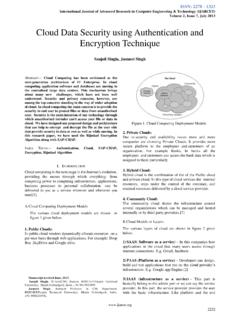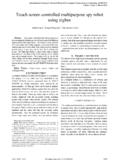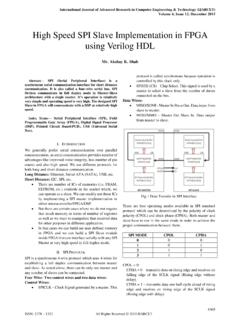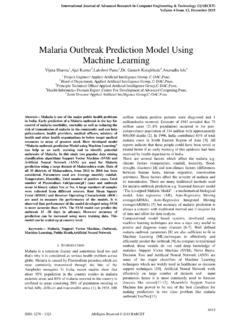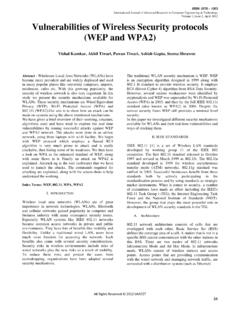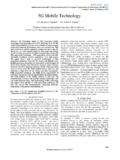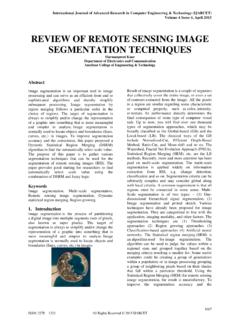Transcription of IDENTIFICATION OF MEASUREMENT ITEMS OF …
1 International Journal of Advanced Research in Computer Engineering & Technology (IJARCET). Volume 4 Issue 12, December 2015. IDENTIFICATION OF MEASUREMENT ITEMS OF. PERFORMANCE DIMENSIONS IN container . PORT TERMINALS. T. Hari Krishna1 N. Vijaya Sai2. M. Ashok Chakravarthy2 V. Sudheer Kumar2. 1. Department of Mechanical Engg, Siddhartha College of Engineering, Vijayawada, India. 2. Department of Mechanical Engg, Siddhartha College of Engineering, Vijayawada terminals into production, productivity, utilization and Abstract Globalization and expansion in international service. trade generated more competitive markets for container terminal industry. Increased customer demands have Junn-Yuan Teng et al (2004) evaluated competitiveness taken substantial effect on the formation of strategies for container terminal operations and in turn became of East Asian region ports using gray relation analysis important for performance evaluation of container with 31 factors .
2 In the study, thirteen criteria (labor terminals. This study suggested a model with sixteen quality, financial liberalization, political, social, and ITEMS under four performance dimensions to evaluate the economical stability, hinterland productivity, ship mean performance of container terminals through service- time in port, loading and discharging ratio, confirmatory factor analysis. Four performance terminal dimensions namely: 1) Throughput measures 2). Productivity Measures 3) Utilization Measures and 4) movement capability, operation cost of carriers, port Service Measures are considered. The result produces a service charge, impact of customs service and validated model that can help in diagnosing performance inbound/outbound ratio) are arrived as critical criteria of container terminals. for competitiveness of the ports. Wiegmans et al. Key Words: container terminals; Performance (2004) presented an operational approach for the Dimensions; Throughput measures; Productivity MEASUREMENT of the quality of container terminal Measures; Utilization Measures; Service quality Measures.
3 Services to identify the critical performance conditions in terms of quality for container terminals. Soner Esmer I. INTRODUCTION (2008) has covered a wide range of performance In Today's complex and competitive environment, dimensions (production, productivity, utilization and container terminals need to measure, monitor, control service Measures) using the container terminals that and improve the performance of the container terminals reviewed in existing literature. Jing Lu et al. (2010). in order to sustain and increase competitiveness. evaluated container terminal service attributes through Performance MEASUREMENT of container terminals is statistical methods such as Internal-Consistency considered as multi-criteria decision making problem as Reliability, Factor Analysis and cluster analysis. The the performance of container terminals depends on study identified five most important container terminal multiple criteria. service attributes (Custom declaration efficiency, Dong-Wook Song and Kevin Cullinane (1999) Loading and discharging efficiency Reliability of the considered TEU throughput to determine the industry's agreed vessel sailing time, Berth availability and Port efficiency and performance using stochastic frontier tariff).
4 Dong-jin KIM (2012) evaluated port efficiencies models. with four productivity criteria (TEUs/year/crane, TEUs/year/length, TEUs/year/area and Kisi et al. (1999) considered performance indicators of TEUs/year/hour) and ranked nineteen European container terminals in four levels namely: labour, cargo, container ports using PROMETHEE methodology. ship and berth. Thomas and Monie (2000) categorized Longjia et al. (2013) performed regression analysis with performance dimensions of container throughput (TEU) as independent variable and ten dependent variables (Total berth length, Port draft, total terminal area, total container yard area, total number of quay cranes, total number of yard cranes, total number 4314. ISSN: 2278 1323 All Rights Reserved 2015 IJARCET. International Journal of Advanced Research in Computer Engineering & Technology (IJARCET). Volume 4 Issue 12, December 2015. of straddle carriers, total number of prime mover II. THE CONCEPTUAL MODEL.)
5 Tractors, total number of trailers and total number of lifters/stackers) using data on the forty ports in East and The proposed model is based on four performance Southeast Asia. Venkata Subbaiah et al. (2014) dimensions (Throughput, Productivity, Utilization and developed hybrid methodology to evaluate container Service quality). In this study, in order to determine the terminals using four categories (Throughput, domain that encompasses container performance productivity, utilization and service of performance dimensions an exhaustive theoretical, empirical and measures. practitioner literature were reviewed. A conceptual frame work is developed by incorporating ideas, Various categories of performance dimensions of theories and studies from literature. In this context, the container terminals are reported in the literature. These following hypotheses are introduced and the conceptual performance dimensions require observable measuring frame work is shown in the Fig.
6 1. ITEMS to evaluate the performance of container terminals. Confirmatory factor analysis is useful H1: ITEMS relating to the throughput measure constitute statistical technique to identify the MEASUREMENT ITEMS performance dimension of container terminals. of the observable variable or latent variable. H2: ITEMS relating to the Productivity measure constitute performance dimension of container terminals. Chang et al. (2008) performed exploratory factor and H3: ITEMS relating to the utility measure constitute confirmatory factor analysis and identified five port performance dimension of container terminals. choice categories, port charge; physical/operational H4: ITEMS relating to the service measure constitute ability of port; advancement/convenience of port;. performance dimension of container terminals. marketability; operational condition of shipping lines;. affecting the choice of port by the shipping companies. Yeo et al. (2008) identifies the components influencing their competitiveness and presents a structure for Throughput Productivity evaluating them using factor analysis.
7 Ines Kolanovi Measure (TM) Measure(PM). (2008) determined port service quality attributes using Ship Throughput Ship (ST) productivity(SP). exploratory factor analysis was used and the convergent Quay transfer Crane and discriminatory validity of the factors have been throughput (QT) productivity(CP). additionally tested by using the confirmatory factor container yard Quay throughput (CT) productivity(QP). and Chiang (2010) explored causal Receipt/delivery terminal area relationships between types of port, influential factors throughput (RT) productivity (TP). and port and Hwang (2010) Equipment productivity(EP). explored causal relationships between influential Labour factors , types of port cooperation, integration of ports productivity(LP). and the overall competitiveness of ports in a region Cost effectiveness (CE). using factor analysis and structure equation Kolanovi et al. (2011) proposed a model defined by five factors for a customer-based port service quality using factor analysis.
8 Caschili and Performance Medda (2013) determined the Port Attractiveness Index Dimensions for 41 container ports of 23 African countries for the of container period 2006-2010 by employing structural equation Terminals modeling approach. Various methods for MEASUREMENT of performance of Services container terminals has been proposed and recognized Utilization Measure (UM) Measure (SM). in previous literatures. But there is little investigation Quay utilization Ship turnaround has identified the reliability and validity of ITEMS of (QU) time (ST). Storage Road vehicle performance dimensions particularly in respect of measure(VM). utilization(SU). container terminals. This study examines and Gate determines ITEMS for measuring the performance of utilization(GU). container terminals of specific regions through Equipment utilization(EU). confirmatory factor analysis. Figure 1 : Conceptual Model of Performance dimensions of container Terminals 4315. ISSN: 2278 1323 All Rights Reserved 2015 IJARCET.
9 International Journal of Advanced Research in Computer Engineering & Technology (IJARCET). Volume 4 Issue 12, December 2015. III. SCALE DEVELOPMENT 5. RESULTS AND DISCUSSION. A list of 17 performance MEASUREMENT ITEMS of A confirmatory factor analysis (CFA) using LISREL. container terminals are considered based on the was used to test the MEASUREMENT model. Also, to literature related performance MEASUREMENT of evaluate the fit of CFA, several goodness-of-fit container terminals and interview with experts in the indicators were used. marine industry. Each item was rated on a five-point Likert scale (1- Strongly disagrees; 2- Disagree; 3- RELIABILITY ASSESSMENT. Undecided; 4- Agree; 5-Strongly agree) according to the following question: please assess the degree to Establishing construct reliability involves testing each which the performance MEASUREMENT ITEMS of container of the multiple indicators of a construct. The traditional terminals need to be adopted or implemented.
10 Measure of reliability is Cronbach's Alpha. Since the data for this research was generated using scaled IV. Data Collection responses, it was deemed necessary to test for reliability. Cronbach's Alpha tests were performed on The data was collected by delivering the questionnaire, the four constructs. Based on the coefficient values, the by email/ in person, to prospective respondents in the ITEMS tested were deemed reliable as they were greater marine logistics. Typically they were the person than responsible for making decisions about container The study tested the MEASUREMENT properties of the terminal functions and were the most knowledgeable performance dimensions of container terminals through informants about the organizations functional activities. confirmatory factor analysis using the data collected A total of 200 questionnaires were distributed, and only from the survey questionnaire shown in Appendix-A. 110 completed surveys were returned, of which only 3 CFA was used to evaluate how well the MEASUREMENT surveys were unusable.
